Trees Birds Mammals Fish Amphibians Reptiles
Wild Algarve
Bookshop
Cortinarius hinnuleus (Sowerby) Fr. - Earthy Webcap
Phylum: Basidiomycota - Class: Agaricomycetes - Order: Agaricales - Family: Cortinariaceae
Distribution - Taxonomic History - Etymology - Toxicity - Identification - Reference Sources
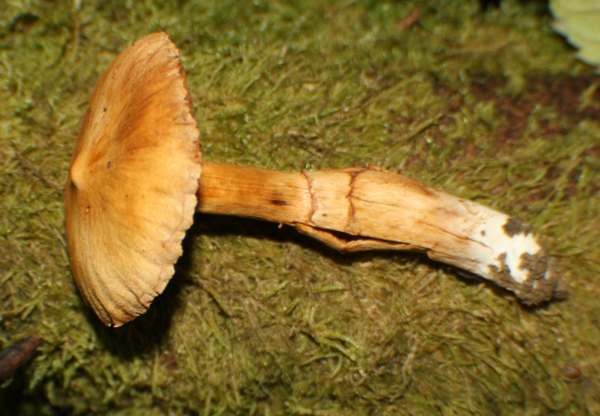
Cortinarius hinnuleus is one of the many brown webcaps found under broadleaf trees. The identification of this undistinguished mushroom is eased somewhat by its habitat needs: damp woodlands with willow or poplar trees.
Distribution
An occasional species in Britain and Ireland, the Earthy Webcap is also found throughout much of mainland Europe and in parts of North America.
Taxonomic history
When in 1798 British naturalist James Sowerby (1757-1822) described the Earthy Webcap he gave it the binomial scientific name Agaricus hinnuleus. (Most gilled fungi were initially placed in a giant Agaricus genus, now redistributed across many other newer genera.) It was the great Swedish mycologist Elias Magnus Fries who, in 1838, transferred this species to the genus Cortinarius, whereupon it assumed its currently-accepted scientific name Cortinarius hinnuleus.
Synonyms of Cortinarius hinnuleus include Agaricus hinnuleus Sowerby, Lepiota helvola Gray, and Cortinarius hinnuleus var. radicata Rob. Henry.
Etymology
The generic name Cortinarius is a reference to the partial veil or cortina (meaning a curtain) that covers the gills when caps are immature. In the genus Cortinarius most species produce partial veils in the form of a fine web of radial fibres connecting the stem to the rim of the cap rather than a solid membrane.
The specific epithet hinnuleus means tawny-cinnamon coloured (the colour of a young hide or fawn).
Toxicity
This mushroom is generally regarded as poisonous and it should not be gathered for eating. (Some brownish Cortinarius species contain the toxin orellanine, which if eaten destroys human kidneys and liver.)
Identification guide
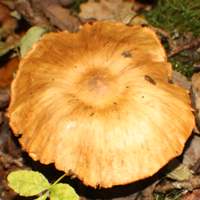 |
Cap
Young caps are bell shaped and dark ochre brown; the pale margin is covered in a whitish cobwebby veil. Mature caps, which usually have a shallow umbo, are hygrophanous, drying out to a mid ochraceous brown; 2.5 to 6cm in diameter.
|
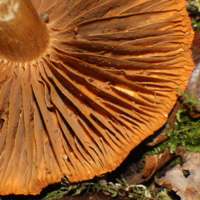 |
Gills
Initially pale buff with a violaceous tinge, turning tawny brown as the spores mature, the gills are adnate and crowded. The cortina covering young gills is white.
Stem
Mid brown, the lower part covered in white silky veil remnants; there is usually a distinct white ring zone; 5 to 12mm diameter and 3 to 10cm tall. Stem flesh white tinged with brown, in young stems flushed violaceous towards the apex. |
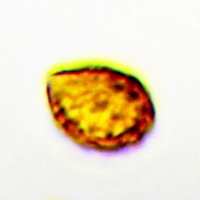 |
Spores
Ellipsoidal, 7-8 x 4-4.75µm, with a minutely roughened surface.
Spore print
Rusty brown. |
Odour/taste |
Taste initially mild then slightly bitter; odour slight, of radish. |
Habitat & Ecological role |
Mycorrhizal, in deciduous woodland with willows and poplars. |
Season |
August to November in Britain and Ireland. |
Similar Species |
Cortinarius flexipes, the Pelargonium Waxcap, is distinguished by its strong odour of pelargoniums (house plant 'geraniums'!) |
Reference Sources
Fascinated by Fungi, 2nd Edition, Pat O'Reilly 2016, reprinted by Coch-y-bonddu Books in 2022.
Funga Nordica, Henning Knudsen and Jan Vesterholt, 2008.
Fungi of Switzerland Agarics, part 3: Cortinariaceae, Breitenbach, J., Kränzlin, F.
British Mycological Society, English Names for Fungi.
Dictionary of the Fungi; Paul M. Kirk, Paul F. Cannon, David W. Minter and J. A. Stalpers; CABI, 2008
Taxonomic history and synonym information on these pages is drawn from many sources but in particular from the British Mycological Society's GB Checklist of Fungi.
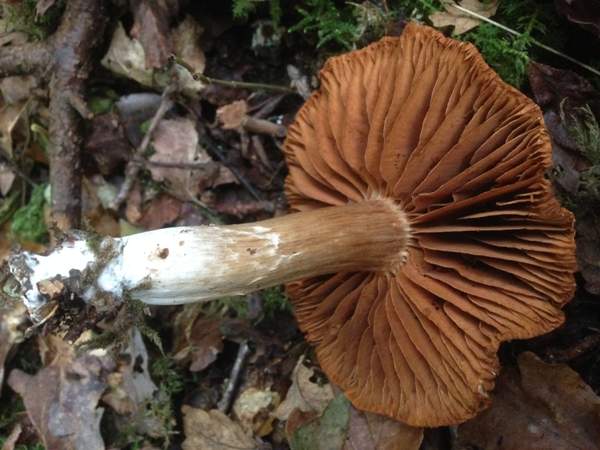
Acknowledgements
This page includes pictures kindly contributed by Simon Harding.
Top of page...
Fascinated by Fungi. Back by popular demand, Pat O'Reilly's best-selling 450-page hardback book is available now. The latest second edition was republished with a sparkling new cover design in September 2022 by Coch-y-Bonddu Books. Full details and copies are available from the publisher's online bookshop...